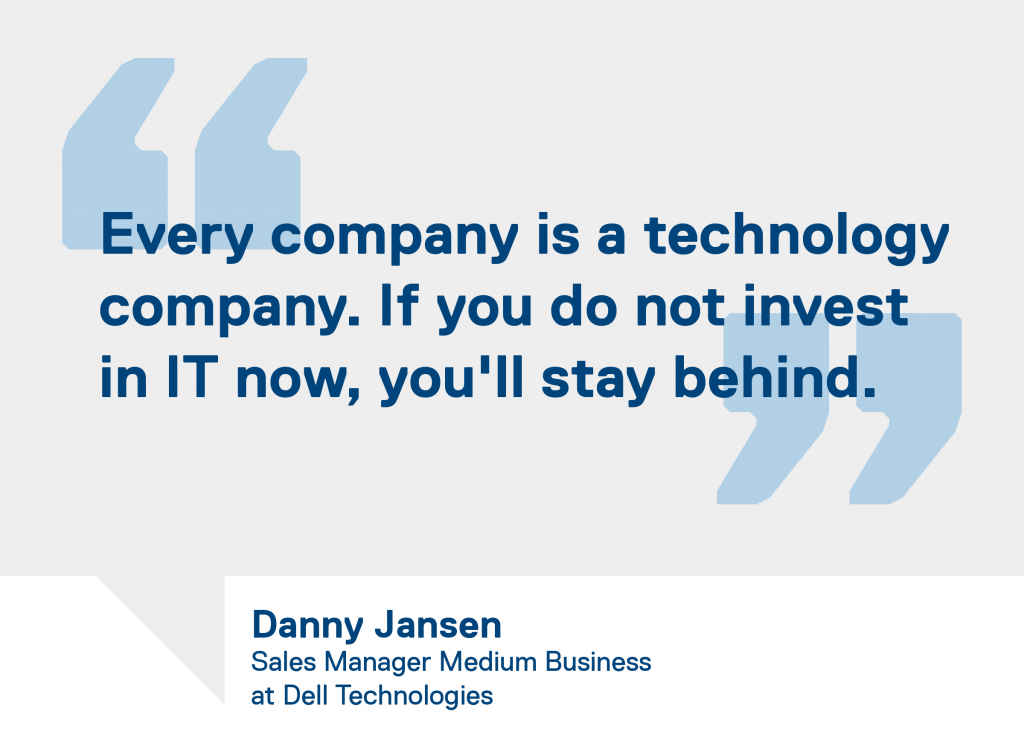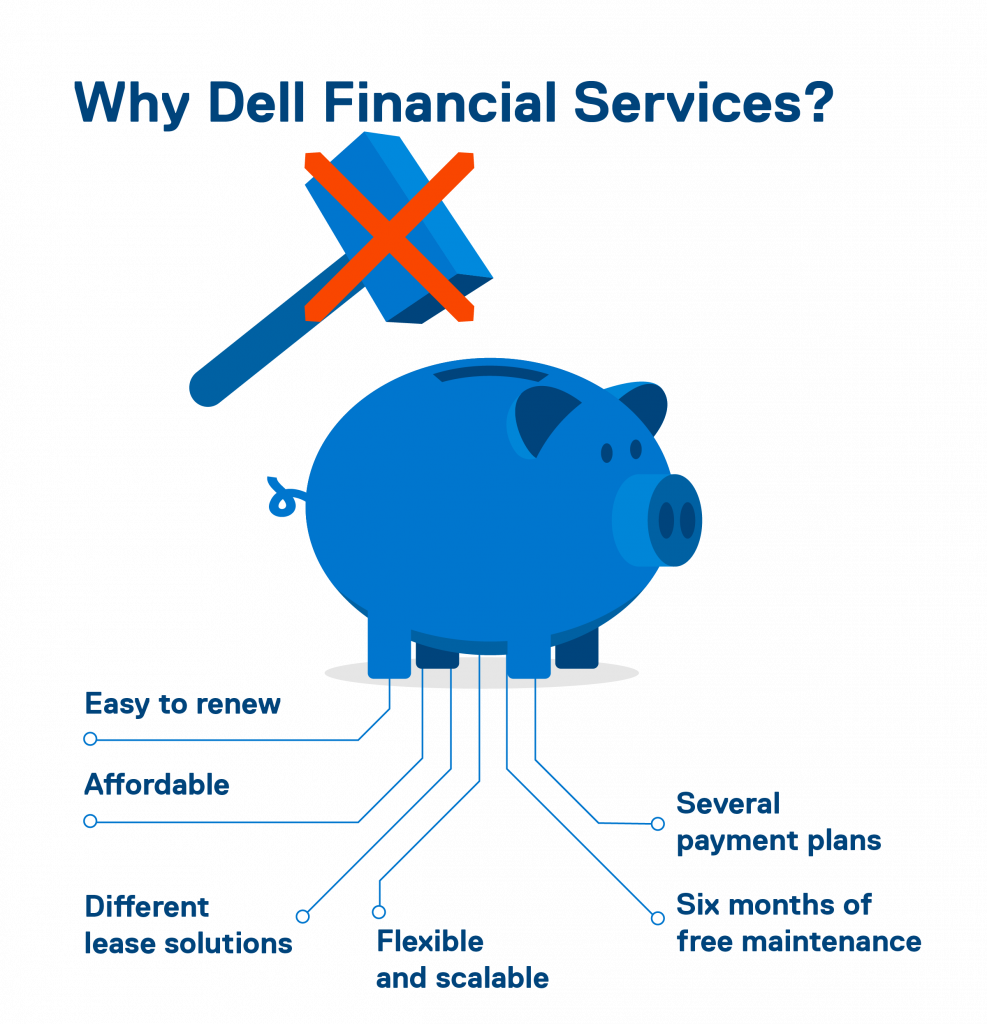Our digitization is in full effect. Anyone in IT has undoubtedly heard the saying “every company is a technology company”. It’s a paradigm shift with a price tag; one that larger enterprises can pay for, but which mid-sized companies are struggling to afford. A study by IDG commissioned by Dell Technologies shows that 53% of all medium-sized companies find it challenging to maintain a sufficient IT budget. But keeping up with a fast-moving market without making a huge investment isn’t impossible. Here’s how you do it:
Make IT your business
Understandably, the mid-sized market doesn’t have the same resources as large corporations. “There is only one budget to set up and protect your IT,” says Danny Jansen, Manager of Medium and Large Business at Dell Technologies. “Businesses prefer to invest in their core business rather than IT. No surprises there, but in the current market this an illogical dichotomy.” What Jansen aims to convey is that cost of ownership in IT nowadays is more about your core business, instead of just IT. In a way, the durability and flexibility of your IT environment determines the success of your company, even though it might not initially seem so.

Almost no mid-sized enterprise can do without a solid IT infrastructure. In order to keep up with the market – to stay ahead of your competitors – you have to invest. Yet, many medium-sized companies seem to be wholly unaware of this. And when they are, they tend to make the wrong decisions. “Medium-sized companies generally have a certain IT legacy – an environment implemented at an earlier stage by in-house experts. That’s where money goes,” says Jansen. In other words: they’re spending more on maintaining existing infrastructures, and less on investing in a new one.
“But,” says Jansen, “making the switch from maintenance to innovation is the right choice. Of course, companies differ, but those who don’t take IT seriously, are becoming increasingly irrelevant. In contrast, companies with a formidable infrastructure are growing explosively these days. It used to take businesses years to increase their market share. Now, we’re talking months.”
Future-proofing your business
Take a bakery, for example. At first glance, an IT investment may seem unnecessary, but the opposite is often true. A baker gets up around 4 in the morning, goes to work and puts bread in the oven. That way, he ensures the bread is ready by the time the first customers drop in. But the same process can be automated. The baker can turn on the oven through an app and when he subsequently arrives at the bakery at 7, the bread is ready to be sold.
It might seem excessive but make no mistake: when a baker does not invest, his or her competitor will. Or even worse: other tech-savvy companies might find innovative ways to sell bread. In about 5 years the baker will notice that it’s lagging behind on its competitors. And then it’ll be too late. If you invest in a decent IT environment now, you’ll be reaping the benefits in the years to come. “Investing in a brand-new environment is not a necessity yet. But being conscious and aware that in the future it will make a difference, is the right strategy,” says Jansen.

Value for your money
It’s safe to say a viable, sustainable IT environment helps businesses grow. And yet, it’s tricky for mid-size enterprises to determine their return-on-investment. Mapping the value of an expensive IT-investment and setting up a payment plan isn’t easy. Luckily, we’re here to help!
First, Dell Technologies is going to have a conversation to determine your wants and needs. Where others start at the end of the funnel, our M.O. is vertical. IT managers often want to innovate, but ultimately, they are not the ones signing leases. “We want everyone to know what kind of investment they are dealing with and what it means for the company’s checkbook,” says Jansen. “After all, a CFO wants to know how things stack up.” Besides that, transparency is very important. Jansen: “Promising customers a Ferrari and delivering a Fiat isn’t beneficial to them nor us. Determining budget and business value first, before taking action, is essential. This way we better meet our customers’ needs.”
Take IT On: making your investment affordable
After we set up a plan, there’s a final obstacle: the price tag. Even for many medium-sized enterprises, IT investments cost millions a year. And those expenses are not taken lightly. This is why we created Dell Financial Services (DFS). “DFS has an official banking license with which we provide customers with financial support models for their IT investments.” In short: Dell Financial Service makes your IT budget scalable, flexible and most importantly, affordable. It is the opposite of working in silos. “The great thing about DFS is that the company that finances your assets also delivers them to your door and installs them. It simplifies our delivery triangle. We go from the client, to the core to the cloud. From service to software,” says Jansen.

From 5k promos to complex payment plans and anything in between: we’re catering to your needs. Jansen: “If you’re keen on making an investment, but your budget is insufficient, we’ll help you with a deferred payment plan. You get your items right away but pay in 6 months when your balance allows it. “Dell Technologies also works with certain baselines. Take online voting guides: during elections, their capacity grows exponentially. We then provide extra power to handle the growth in traffic. If numbers drop after the elections are over, we push some buttons, the capacity shrinks to baseline and they pass less.”
IDG survey
The complete IDG survey – with unique insights in the field of medium-sized companies and IT – can be downloaded here. We map the challenges and challenges of medium-sized companies and analyze bottlenecks.
